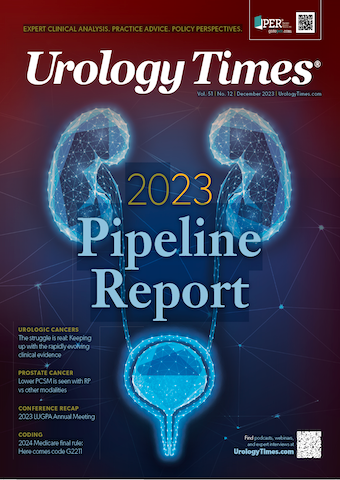Commentary
Article
Urology Times Journal
The struggle is real: Keeping up with the rapidly evolving clinical evidence in urology
Author(s):
"Keeping up-to-date is challenging, and rapid progress that is now occurring in our field is truly amazing," writes Michael S. Cookson, MD, MMHC, FACS.
“We are drowning in information but starved for knowledge.”—John Naisbitt
Michael S. Cookson, MD, MMHC, FACS

Like most of you, I appreciate data-driven approaches to medicine and try, when possible, to adhere to evidence-based medicine. Historically, well-constructed guidelines from trusted, reliable sources have helped provide a good reference for clinical guidance. And in what I will refer to as “simpler” times, there seemed to be relatively close alignment between the published literature and the updated guidelines. However, is it just me, or does it now seem like the quality and pace of scientific discovery is outpacing the guidelines? In football terminology, it appears that we are “outkicking our coverage.” In addition, it seems that most guidelines operate independently, and the ability to update is almost directly related to the methodology, rigor, and grading system that each organization employs.
Let me explain some of the more recent examples, just in the disease state of advanced prostate cancer. I am particularly sensitive to this area, having spent almost a decade on the American Urological Association/Society of Urologic Oncology Advanced Prostate Cancer (APC) Guidelines.1 In the spring this year, the 2023 APC Update was published. However, less than 6 months later, these updates now need further consideration for revision. The management of biochemical recurrence (BCR) just got more informed with the recently published results of the phase 3 EMBARK trial (NCT02319837).2 In this study of men with BCR after surgery or radiation therapy at high risk for progression as defined as those with a prostate-specific antigen doubling time of less than 9 months, leuprolide, a luteinizing hormone-releasing hormone agonist, plus enzalutamide (Xtandi) and enzalutamide monotherapy both were superior to leuprolide alone in terms of improving metastasis-free survival. At 5 years, metastasis-free survival was 87.3% in the combination group, 71.4% in the leuprolide-alone group, and 80.0% in the monotherapy group. So, the combination of androgen deprivation therapy plus enzalutamide and enzalutamide alone both were superior to leuprolide therapy in these high-risk patients with BCR. The impact of treatment on overall survival will require further follow-up. Also, these patients underwent conventional imaging, so the incorporation of these findings among patients with prostate-specific membrane antigen PET imaging will require further clinical nuancing.
There were also recently published data in the management of first-line metastatic castration-resistant prostate cancer (mCRPC). In these trials, a PARP inhibitor was added to a standard of care androgen-directed therapy. In the phase 3 PROpel trial (NCT03732820), abiraterone (Zytiga) and prednisone (AAP) plus olaparib (Lynparza) was compared with AAP and placebo in patients with or without deleterious BRCA-mutated mCRPC demonstrated a statistically significant improvement in radiographic progression-free survival (rPFS) for abiraterone and olaparib compared with abiraterone and placebo.3 In a second phase 3 trial, MAGNITUDE (NCT03748641), assessed first-line treatment of patients with mCRPC who were prospectively identified as homologous recombination repair positive with/without BRCA1/2 alterations and randomized to niraparib (Zejula) plus AAP or placebo plus AAP.4 In this study, the combination of niraparib plus AAP, as compared with AAP plus placebo, reduced risk of radiographic progression/death by 45% in BRCA1/2-altered mCRPC at a median follow-up of 24.8 months. A third trial of combination therapy in first-line mCRPC has been reported. TALAPRO-2 (NCT03395197) is a randomized, phase 3 trial of talazoparib (Talzenna) plus enzalutamide vs placebo plus enzalutamide as first-line therapy in men with mCRPC.5 Talazoparib plus enzalutamide resulted in statistically significantimprovement in rPFS vs standard of care enzalutamide as first-line treatment for patients with mCRPC. In each of these trials, the overall survival data and additional long-term safety follow-up will further clarify the clinical benefit of the treatment combination in mCRPC patients.
In the meantime, what recommendations can be made to ensure that our guidelines are updated and timely, while still retaining a high level of sophistication with respect to interpretation of the evidence? To this end, there are several important ingredients for continued success. A cadence of regular committee reviews and continuous data analysis to monitor and analyze the latest research and clinical trial data will help keep guidelines refreshed. When appropriate, guidelines should adapt to the emerging field of precision-based medicine, considering biomarkers, genetic testing, and personalized treatment plans. Another area of potential improvement includes collaborating and networking. Currently, there are very few national and even fewer international collaborations to exchange knowledge and best practices when it comes to guidelines. Another area of improvement would be in the arena of patient-centered care. Ensuring guidelines consider the preferences and values of patients, incorporating shared decision-making, quality of life, and financial toxicity, should be prioritized. Utilizing digital platforms and technology to facilitate access to the latest guidelines may help ensure health care providers stay informed. Regular and thorough multidisciplinary reviews, combined with a patient-centric approach and the incorporation of the latest research, are key to keeping prostate cancer guidelines up-to-date with medical progress.
Keeping up-to-date is challenging, and rapid progress that is now occurring in our field is truly amazing. By keeping abreast of the latest published results, we will continue to provide our patients with vital and potentially life-prolonging therapies. Guidelines, along with rapid dissemination through multiple educational platforms, will continue to provide a valuable service to update the busy clinician in the management of patients in this rapidly evolving disease state.
References
1. Lowrance W, Dreicer R, Jarrard DF, et al. Updates to advanced prostate cancer: AUA/SUO guideline (2023). J Urol. 2023;209(6):1082-1090. doi:10.1097/JU.0000000000003452
2. Freedland SJ, de Almeida Luz M, De Giorgi U, et al. Improved outcomes with enzalutamide in biochemically recurrent prostate cancer. N Engl J Med. 2023;389:1453-1465. doi:10.1056/NEJMoa2303974
3. Clarke NW, Armstrong AJ, Thiery-Vuillemin A, et al. Abiraterone and olaparib for metastatic castration-resistant prostate cancer. N Engl J Med Evid. 2022;1(9):1-16. doi:10.1056/EVIDoa2200043
4. Chi KN, Sandhu S, Smith MR, et al. Niraparib plus abiraterone acetate with prednisone in patients with metastatic castration-resistant prostate cancer and homologous recombination repair gene alterations: second interim analysis of the randomized phase III MAGNITUDE trial.
Ann Oncol. 2023;34(9):772-782. doi:10.1016/j.annonc.2023.06.009
5. Agarwal N, Azad AA, Carles J, et al. Talazoparib plus enzalutamide in men with first-line metastatic castration-resistant prostate cancer (TALAPRO-2): a randomised, placebo-controlled, phase 3 trial. Lancet. 2023; 402(10398):291-303. doi:10.1016/S0140-6736(23)01055-3



























